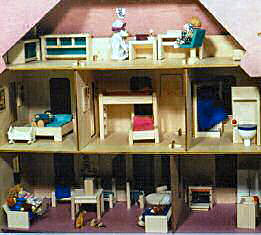|
|
||
|
|
A variety of toys helps children communicate a wide range of thoughts and feelings |
|
Diagnostic and Therapeutic Play with Children
|
|
||
|
|
A variety of toys helps children communicate a wide range of thoughts and feelings |
|
Play interviews may include verbal conversation, art, building, throwing a ball, and pretend play with toys. These interviews add to a diagnostic evaluation by providing a view from the child’s perspective. Such a view balances the other sources of data, such as tests, history, and behavior questionnaires. The environment for play interviews must encourage and respect children's nonverbal self-expression and communication. In play therapy, this process becomes an agent of change through the therapeutic relationship and the child's ability to experience and understand things in different ways.
 |
||
|
A dollhouse helps children think about important relationships and routines of daily life |
||
Some children need help with developing their play skills, or with the integration of verbal and nonverbal skills. Others need help in using their play skills to express and resolve conflicts. In play therapy, the therapist "reads" the child’s play expressions and responds in a therapeutic manner. This usually involves a combination of verbal and nonverbal interaction. It also requires that a therapeutic relationship be established in which the child can feel free to communicate both nonverbally and verbally. Toys and other playroom supplies are really windows into the child's feelings and ideas.
|
|
||
|
Children communicate via art as well as pretend play with toys |
||
The therapy process includes the relationships children develop with the toys they use to express themselves. If the child cannot depend on the regularity of the sessions, and the continuity of the environment, therapy is much more difficult. Additionally, the child's therapist must meet regularly (but usually less often) with the child's parents. The therapist must learn from the parents. They give the therapist their observations and their perspective, so that data from therapy sessions can be integrated with data from the rest of the child's life. While respecting the child's confidentiality, the therapist can give parents a valuable perspective for understanding their child's behavior. The therapist can also advise parents about questions such as behavior management, educational concerns, and recreation activities that will facilitate the child's development. Finally teachers, nannies or day care workers, and other important people can also provide important data.
 |
||
| Toys for building and active play | ||
Copyright © 2015 Tom Holman, Ph.D. All rights reserved.